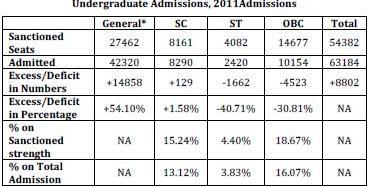Anshul Kumar
 “History shows that the Brahmin has always had other classes as his allies to whom he was ready to accord the status of a governing class provided they were prepared to work with him in subordinate co-operation. In ancient and medieval times he made such an alliance with the Kshatriyas or the warrior class and the two ruled the masses, indeed ground them down, the Brahmin with his pen and the Kshatriya with his sword. At present, the Brahmin has made an alliance with the Vaishya class called Banias. The shifting of this alliance from Kshatriya to Bania is natural. In these days of commerce money is more important than sword. That is one reason for this change in party alignment. The second reason is the need for money to run the political machine. Money can come only from the Bania. It is the Bania who is financing the Congress largely because Mr. Gandhi is a Bania and also because he has realized that money invested in Politics gives large dividends.” ~ BR Ambedkar in What Congress and Gandhi have done to the Untouchables
“History shows that the Brahmin has always had other classes as his allies to whom he was ready to accord the status of a governing class provided they were prepared to work with him in subordinate co-operation. In ancient and medieval times he made such an alliance with the Kshatriyas or the warrior class and the two ruled the masses, indeed ground them down, the Brahmin with his pen and the Kshatriya with his sword. At present, the Brahmin has made an alliance with the Vaishya class called Banias. The shifting of this alliance from Kshatriya to Bania is natural. In these days of commerce money is more important than sword. That is one reason for this change in party alignment. The second reason is the need for money to run the political machine. Money can come only from the Bania. It is the Bania who is financing the Congress largely because Mr. Gandhi is a Bania and also because he has realized that money invested in Politics gives large dividends.” ~ BR Ambedkar in What Congress and Gandhi have done to the Untouchables
India is a very peculiar nation state, even by the peculiar standards of oriental nation states. This strange yet unique feature of the Indian nation state is attributable rightly so to the institution of Caste which governs the political economy, markets, societies, religious and cultural spheres of everyday lives of individuals. It was not far fetched when noted Anthropologist Nicolas Dirks stated that, “When thinking of India, it is difficult not to think of Caste”.
When thinking of Class, it is important to keep in mind that the fight of the proletariat is against the bourgeoisie. Similarly when thinking of Caste, it is important to keep in mind that the struggle is between the apex ruling Caste, the Brahmins and the rest as subordinate to the Brahmin. The only problem is that the apex ruling caste always remain hidden.
Babasaheb has very emphatically written that “History of India is nothing but the conflict between Brahmanism and Buddhism”. These two opposing strands of ideologies have always been in conflict with each other and their dialectics is what has governed the political economy and societies which have emerged from time to time. The word to be noted here is “Conflict”. This suggests that these two opposing ideologies were as popular and there was a struggle among both to dominate. It would not be entirely true to accept that Brahmanism has always been a ruling force and Buddhism, a defeated idea. That is why it’s an ongoing struggle. Of late, of course the Brahmins have managed to strangle the system with the help of their allied upper castes. Historically they have always tried doing that. They have always known they are a minority and therefore, that they need the support of others who can benefit them materially and ideologically to rule with ease.
For a long period of time their allies were the warrior aristocrats, the Kshatriyas, as the pre-modern Indian societies were largely feudal and to sustain feudalism one requires a martial society, where the dominance is governed by muscle power. Brahmins sought the help of warrior castes to build their dominance by the use of force. This was made possible by the social legitimacy that the Brahmins granted to the kings from warrior castes by writing paeans in their names and giving them titles like “Maharajadhiraja”, “Vikramaditya” and other larger than life pretentious sounding names. This was done not just to provide legitimacy to their martial rule over the territory, but huge parcels of land were granted to the Brahmans for free, which has been called as “Brahmdeya”.
With the advent of British, the times changed and largely, the societies too changed. The era of globalisation was already there and more than martial forces, markets started to gain dominance in governing human relationships and interactions. That is why during that period many erstwhile castes which were lower in hierarchy became materially affluent by tapping the potential of commerce and trade that increased with the introduction of British Imperialism. Caste hierarchies were changing and who could have known that better than those who created the Castes in the first place, the Brahmins.
Under the British Raj, the Kshatriyas had already become indolent, passive and almost neutered by British diplomacy beyond any repair. Their arrogance of being warlords was already shattered and they were made into puppet rulers with the real power resting in the British Crown. Now all they did was to survive on huge sums of money given by the British in the form of pensions and remained content with the fact they are Rajputs, the Royals, the nobles. This haughty behaviour of them was the very reason of their defeat and they tried to assuage their deep buried pain by celebrating the birthdays and marriages of their dogs and flaunting antique pieces of jewellery and artefacts. This condition of the Kshatriyas was very well known to the Brahmins of that time, that is why the Brahmins pampered and bootlicked the British to help them maintain their hegemony over the Indian societies and not the Kshatriyas. That was the beginning of the phase where the loyalties of the Kshatriyas were no longer of any material need to the Brahmins. This can be observed in the recent and sudden rise of Yogi Adityanath, a Kshatriya by Caste to the rank of Chief Minister of the Uttar Pradesh. The rise of Yogi is a clarion call by the Kshatriyas to the Brahmins as if they are screaming out loud that our services are still important and we are worthy of your loyalties. But the Brahman knows where to seek his allies. Till how long this tussle between the Brahman and Kshatriyas will continue is uncertain but it’s a fact that Brahmins have already stopped giving them much importance materially. Whatever little recognition the Kshatriyas are getting is largely to keep the religious and mythological binary of Hindu and Muslim running in the name of Ram Rajya, so that the Brahman can weave new equations and alliances in the background.
“The Bania is the worst parasitic class known to history. In him the vice of money-making is unredeemed by culture or conscience. He is like an undertaker who prospers when there is an epidemic. The only difference between the undertaker and the Bania is that the undertaker does not create an epidemic while the Bania does. He does not use his money for production. He uses it to create poverty and more poverty by lending money for unproductive purposes. He lives on interest and as he is told by his religion that money lending is the occupation prescribed to him by Manu, he looks upon it as both right and righteous. With the help and assistance of the Brahmin judge who is read to decree his suits, he is able to carry on his trade. Interest, interest on interest, he adds on and on and thereby draws families perpetually into his net: Pay him as much as a debtor may, he is always in debt. With no conscience, there is no fraud, and no chicanery that he will not commit. His grip over the nation is complete. The whole of poor, starving, illiterate India is mortgaged to the Bania.To sum up, the Brahmin enslaves the mind and the Bania enslaves the body. Between them, they divide the spoils which belong to the governing classes.” ~ BR Ambedkar in What Congress and Gandhi have done to the Untouchables
Post Second World War, market societies were gaining much more prominence the world over and Indian nation state came into existence. The old allies of the Brahman, the Kshatriyas had already lost importance and the Brahmans were looking for a new “class” to further their hegemony. For quite a period of time they managed without any allies by creating a Brahman bureaucratic elite in the form of IAS, IPS and a technocratic elite that emerged from IITs and IIMs. Meanwhile the process of finding new allies was still on. Very calculated steps were being taken this time so that the allies don’t overpower them and become as worrying as the Kshatriyas. That is the prime reason, despite being fully aware of the market societies gaining prominence, they made the Indian state to follow an apparently socialist economy where markets were under government control. Along with this, the process of consolidation of the Brahman in academia, media, judiciary was on and the they were again becoming the key change makers and held enough power to sway and at times define public opinion. This was purely done to keep the new allies, the Baniyas, under check and in their limits. It is often a misunderstood fact that India is becoming a Crony Capitalist state. The real hold is still in the hands of the Brahmans, Capitalist Class, the Baniyas are fortunate enough to be in a time period where their services are required by the Brahmans.
Post Independence, a paradigm shift in the Indian nation state was the passing of the Mandal commission report, which granted the OBC reservation in employment. This paradigm shift again was a marker of the lost Kshatriya glory and their abandonment as allies by the Brahmans which erupted in the politics of V.P Singh, again a Kshatriya.
Just after independence, the Brahman was busy in building another set of allies. These allies were the numerically stronger agrarian castes like Jats, Kurmis and Jatt Sikhs. As the population was increasing at faster rates every passing decade, there was a need to feed the growing population. Here one might get the wrong idea that the intention of the State was to feed the entire population. No, this was not the reality. With each passing decade in 20th Century, the Brahmin population was increasing in cities and urban landscapes and it was becoming increasingly difficult to arrange for their dietary needs. So in order to use the labour of the agrarian castes and other castes lower in hierarchy, the sham, the charade of Land Reforms act was introduced.
The intention of the Brahman was to ensure the that their bellies were filled and not really cared about the larger population because if that had been the case then even in 2020, 3000 people would not have been dying of hunger daily. So, now post Mandal agitations, the agrarian castes have revolted, that forced the Brahman to open the gates of the apparently socialist economy and enter into a neoliberal free market world and fall back again to their other allies the Baniyas. The association of agrarian and other backward castes with anti-caste politics has irked the Brahmans and they were already thinking of getting rid of them. While these agrarian castes like Jats, Jatt Sikhs, Kurmis, Yadavs were busy in claiming to be Rajputs and fighting hard to gain the loyalty of the Brahman, the Brahman had already thought of kicking them out just like the Rajputs, the Kshatriyas.
That point of time when the Brahman has to take action and throw away the agrarian castes and show them their place is already here. The zenith of the neo liberal regime is knocking on the door and the Brahman is busy again with Baniyas as his allies, to weave once again new equations and manipulations to find new “classes” which will act as their allies in the information societies, IT societies which are the future. One might find strange new caste hierarchies emerging and maybe this time class background and the proximity to the Brahmin will decide which new Castes or a section of these Castes will be their allies. It could very well be from Bahujan castes themselves. Until the Bahujans, realise how the Brahman is playing the game, they won’t be able to overthrow him again as was done by the Buddha. It is important thus for Bahujans to identify where their loyalties and priorities should lie and not to be swayed by the leftovers thrown by the Brahman engrossing themselves in the false pride of their respective castes.
~~~
Anshul Kumar is a graduate in sociology and anthropology.










